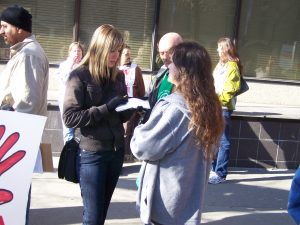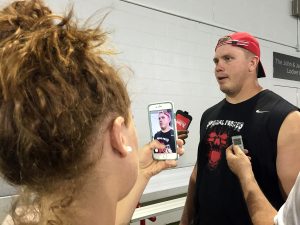2.1: Let's Interview
- Page ID
- 126052
\( \newcommand{\vecs}[1]{\overset { \scriptstyle \rightharpoonup} {\mathbf{#1}} } \)
\( \newcommand{\vecd}[1]{\overset{-\!-\!\rightharpoonup}{\vphantom{a}\smash {#1}}} \)
\( \newcommand{\dsum}{\displaystyle\sum\limits} \)
\( \newcommand{\dint}{\displaystyle\int\limits} \)
\( \newcommand{\dlim}{\displaystyle\lim\limits} \)
\( \newcommand{\id}{\mathrm{id}}\) \( \newcommand{\Span}{\mathrm{span}}\)
( \newcommand{\kernel}{\mathrm{null}\,}\) \( \newcommand{\range}{\mathrm{range}\,}\)
\( \newcommand{\RealPart}{\mathrm{Re}}\) \( \newcommand{\ImaginaryPart}{\mathrm{Im}}\)
\( \newcommand{\Argument}{\mathrm{Arg}}\) \( \newcommand{\norm}[1]{\| #1 \|}\)
\( \newcommand{\inner}[2]{\langle #1, #2 \rangle}\)
\( \newcommand{\Span}{\mathrm{span}}\)
\( \newcommand{\id}{\mathrm{id}}\)
\( \newcommand{\Span}{\mathrm{span}}\)
\( \newcommand{\kernel}{\mathrm{null}\,}\)
\( \newcommand{\range}{\mathrm{range}\,}\)
\( \newcommand{\RealPart}{\mathrm{Re}}\)
\( \newcommand{\ImaginaryPart}{\mathrm{Im}}\)
\( \newcommand{\Argument}{\mathrm{Arg}}\)
\( \newcommand{\norm}[1]{\| #1 \|}\)
\( \newcommand{\inner}[2]{\langle #1, #2 \rangle}\)
\( \newcommand{\Span}{\mathrm{span}}\) \( \newcommand{\AA}{\unicode[.8,0]{x212B}}\)
\( \newcommand{\vectorA}[1]{\vec{#1}} % arrow\)
\( \newcommand{\vectorAt}[1]{\vec{\text{#1}}} % arrow\)
\( \newcommand{\vectorB}[1]{\overset { \scriptstyle \rightharpoonup} {\mathbf{#1}} } \)
\( \newcommand{\vectorC}[1]{\textbf{#1}} \)
\( \newcommand{\vectorD}[1]{\overrightarrow{#1}} \)
\( \newcommand{\vectorDt}[1]{\overrightarrow{\text{#1}}} \)
\( \newcommand{\vectE}[1]{\overset{-\!-\!\rightharpoonup}{\vphantom{a}\smash{\mathbf {#1}}}} \)
\( \newcommand{\vecs}[1]{\overset { \scriptstyle \rightharpoonup} {\mathbf{#1}} } \)
\( \newcommand{\vecd}[1]{\overset{-\!-\!\rightharpoonup}{\vphantom{a}\smash {#1}}} \)
\(\newcommand{\avec}{\mathbf a}\) \(\newcommand{\bvec}{\mathbf b}\) \(\newcommand{\cvec}{\mathbf c}\) \(\newcommand{\dvec}{\mathbf d}\) \(\newcommand{\dtil}{\widetilde{\mathbf d}}\) \(\newcommand{\evec}{\mathbf e}\) \(\newcommand{\fvec}{\mathbf f}\) \(\newcommand{\nvec}{\mathbf n}\) \(\newcommand{\pvec}{\mathbf p}\) \(\newcommand{\qvec}{\mathbf q}\) \(\newcommand{\svec}{\mathbf s}\) \(\newcommand{\tvec}{\mathbf t}\) \(\newcommand{\uvec}{\mathbf u}\) \(\newcommand{\vvec}{\mathbf v}\) \(\newcommand{\wvec}{\mathbf w}\) \(\newcommand{\xvec}{\mathbf x}\) \(\newcommand{\yvec}{\mathbf y}\) \(\newcommand{\zvec}{\mathbf z}\) \(\newcommand{\rvec}{\mathbf r}\) \(\newcommand{\mvec}{\mathbf m}\) \(\newcommand{\zerovec}{\mathbf 0}\) \(\newcommand{\onevec}{\mathbf 1}\) \(\newcommand{\real}{\mathbb R}\) \(\newcommand{\twovec}[2]{\left[\begin{array}{r}#1 \\ #2 \end{array}\right]}\) \(\newcommand{\ctwovec}[2]{\left[\begin{array}{c}#1 \\ #2 \end{array}\right]}\) \(\newcommand{\threevec}[3]{\left[\begin{array}{r}#1 \\ #2 \\ #3 \end{array}\right]}\) \(\newcommand{\cthreevec}[3]{\left[\begin{array}{c}#1 \\ #2 \\ #3 \end{array}\right]}\) \(\newcommand{\fourvec}[4]{\left[\begin{array}{r}#1 \\ #2 \\ #3 \\ #4 \end{array}\right]}\) \(\newcommand{\cfourvec}[4]{\left[\begin{array}{c}#1 \\ #2 \\ #3 \\ #4 \end{array}\right]}\) \(\newcommand{\fivevec}[5]{\left[\begin{array}{r}#1 \\ #2 \\ #3 \\ #4 \\ #5 \\ \end{array}\right]}\) \(\newcommand{\cfivevec}[5]{\left[\begin{array}{c}#1 \\ #2 \\ #3 \\ #4 \\ #5 \\ \end{array}\right]}\) \(\newcommand{\mattwo}[4]{\left[\begin{array}{rr}#1 \amp #2 \\ #3 \amp #4 \\ \end{array}\right]}\) \(\newcommand{\laspan}[1]{\text{Span}\{#1\}}\) \(\newcommand{\bcal}{\cal B}\) \(\newcommand{\ccal}{\cal C}\) \(\newcommand{\scal}{\cal S}\) \(\newcommand{\wcal}{\cal W}\) \(\newcommand{\ecal}{\cal E}\) \(\newcommand{\coords}[2]{\left\{#1\right\}_{#2}}\) \(\newcommand{\gray}[1]{\color{gray}{#1}}\) \(\newcommand{\lgray}[1]{\color{lightgray}{#1}}\) \(\newcommand{\rank}{\operatorname{rank}}\) \(\newcommand{\row}{\text{Row}}\) \(\newcommand{\col}{\text{Col}}\) \(\renewcommand{\row}{\text{Row}}\) \(\newcommand{\nul}{\text{Nul}}\) \(\newcommand{\var}{\text{Var}}\) \(\newcommand{\corr}{\text{corr}}\) \(\newcommand{\len}[1]{\left|#1\right|}\) \(\newcommand{\bbar}{\overline{\bvec}}\) \(\newcommand{\bhat}{\widehat{\bvec}}\) \(\newcommand{\bperp}{\bvec^\perp}\) \(\newcommand{\xhat}{\widehat{\xvec}}\) \(\newcommand{\vhat}{\widehat{\vvec}}\) \(\newcommand{\uhat}{\widehat{\uvec}}\) \(\newcommand{\what}{\widehat{\wvec}}\) \(\newcommand{\Sighat}{\widehat{\Sigma}}\) \(\newcommand{\lt}{<}\) \(\newcommand{\gt}{>}\) \(\newcommand{\amp}{&}\) \(\definecolor{fillinmathshade}{gray}{0.9}\)“Some of the best advice I can give to young reporters in an interview is to just shut up.”
Mike Wagner
Most of us think interviews are simply asking questions and getting answers, but true interview skills come from asking the right questions of the right sources and gathering all of the information your reader needs and wants to know.

An interview can be defined as an interaction between two people, where questions are asked to elicit information. They are the key, quite simply, to information transmission, be it socially, formally or in business. And that is why journalists use interviews every day to find and report the news that keeps a society informed.
If that sounds like a conversation, good because that is the fundamental structure of an interview done well. But that is not all it is.
“It’s almost like any relationship in life — the more conversational you are, the more you seem invested in what they have to say, the more willing they are going to be to open up,” The Athletic’s Zack Meisel said. “It takes time.”
Too often journalists view interviews solely as the time and space in which to ask questions they have jotted into a notebook. That is a logical but superficial view. The quality and useful end product of an interview come actually from a lengthy equation combining:
- Knowledge your story.
- Identifying the facts of your story.
- Determining what information you need for that story.
- Determining what kind of sources you need to get that information.
- Finding sources for that story who can provide the answers you need.
- Working out when and where to meet those sources.
- Conceptualizing a mix of open- and closed-ended questions to get the information you need.
- Asking questions in a way that they can get the facts you need and result in at least some good, usable quotes.
- Getting information down quickly and accurately.
- Selecting which facts and quotes best present information your reader needs.
Sounds simple, right?
In truth, interviews are anything but simple, as they involve asking questions that reflect the information sought as clearly, yet conversationally, as possible. They require listening to and analyzing answers, while at the same time figuring out what to ask next. Interviewers must be nimble, ready to react in the event an answer results in a change to the direction of the conversation or, more significantly, the article being pursued. Interviewers read body language and between the lines of what is and is not being said.

“That is something that just doesn’t get taught a lot in collegiate programs,” said Lucas Sullivan of The Dispatch. “I never had a professor tell me if you just invest the time and learn how to talk to someone like a human being that is half the battle. Instead, you get this very clinical, look at this report and look at how they did it and look at the sources and list all the sources to me. You never get the behind the scenes, like how do you really craft this web and that is how it is really done. It is really done by putting in the time. You could do this too. Someone in your life or someone at a bar or someone you are riding the bus with. Test yourself and see if you can get them to tell you one personal thing about them. Then you start to hone that and you feel comfortable.”
Much like a house will crumble on a weak foundation, so do articles founder when based on poor interviews. The quality of sources, the depth of the questions, the understanding of the subject, and the ability to transmit that subject information to others are key to successful journalism. And much of them start with the interviews conducted with sources who provide journalism with the primary source material.
Just because you can ask a question does not mean you have conducted an interview. Understanding these basics behind what makes a strong interview will get us started.
It’s all about the conversation
We interview every day. They might start by asking a family member or roommate how their day might unfold. It might continue in class or at a job while you figure out the parameters of an assignment. It might happen in a restaurant when you are trying to figure out what on the menu might be gluten-free. When your doctor asks questions to diagnose a cough that is lingering, she is conducting an interview.
Not every encounter, however, is as fruitful as it could be, and we have all had moments of miscommunication (at best), or even unintended offense (at worst). A conversation cannot truly be successful unless both parties are engaged and care about what the other said. As Stephen R. Covey said in “The 7 Habits of Highly Effective People: Powerful Lessons in Personal Change,” “Most people do not listen with the intent to understand; they listen with the intent to reply.” The same is true in journalistic interviewing.
“I ask myself, what are my main objectives for this interview?” Sullivan said. “What do want to leave knowing, getting, whatever from this interview? That is how I frame. I am not someone who writes down my questions. I have them in my head usually they are just topics that I want to go through because I want to have a conversation. I don’t want to just say OK I am on question seven of my 10 questions.
“Try not to be so rigid about it and you have to ask yourself before you go in, what are my objectives? What do I hope to leave with? And ask the questions accordingly.
Think about the biggest challenges we face in communicating conversationally:
- Distractions, like texting while others talk.
- Asking closed questions that require one-word responses.
- Talking about what we know instead of finding out what others know.
- Asking questions because we feel we have to, without caring about the answer.
The same issues run parallel in journalism. Distracted communication comes from scribbling instead of making eye contact and worrying so much about what question comes next that you fail to hear what your source is saying about the current question. We pretend we understand because we fear to look stupid. We ask questions without truly caring about the answer.
In feature interviewing done well, there is likely to be another element to the interviewing process that goes beyond the formal process we imagine of traditional reporting. This other form of interviewing is more casual — the walk and talk while exploring a place of work, a kitchen conversation. This is when watching and feeling become just as important as hearing and writing.
The way people speak and move can reveal much about them — from education to age, ethnicity to ethics. To uncover these nuggets means going beyond the words to the voice, mannerisms and gestures that make people come to life on the page.


